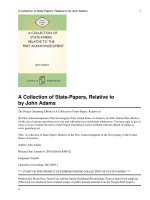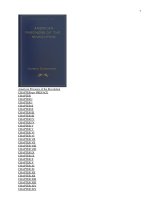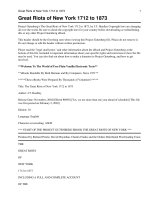Economic Report of the President 2008 (Economic Report of the President Transmitted to the Congress) potx
Bạn đang xem bản rút gọn của tài liệu. Xem và tải ngay bản đầy đủ của tài liệu tại đây (11.91 MB, 353 trang )
Transmitted to the Congress February 2008
Together with the Annual Report
of the Council of Economic Advisers
Economic Report of the President • February 2008
Economic
Report
of the
President
ERP_Cover_Proofs with green barcode.indd 1ERP_Cover_Proofs with green barcode.indd 1 1/30/2008 11:49:44 AM1/30/2008 11:49:44 AM
Economic Report
of the President
For sale by the Superintendent of Documents, U.S. Government Printing Office
Internet: bookstore.gpo.gov Phone: (866) 512-1800; DC area (202) 512-1800
ISBN 978-0-16-079822-1
Transmitted to the Congress
February 2008
together with
THE ANNUAL REPORT
of the
COUNCIL OF ECONOMIC ADVISERS
UNITED STATES GOVERNMENT PRINTING OFFICE
WASHINGTON : 2008
Fax: (202) 512-2104 Mail Stop: IDCC, Washington, DC 20402-0001
CONTENTS
ECONOMIC REPORT OF THE PRESIDENT
ANNUAL REPORT OF THE COUNCIL OF ECONOMIC ADVISERS*
CHAPTER 1. THE YEAR IN REVIEW AND THE YEARS AHEAD
CHAPTER 2. CREDIT AND HOUSING MARKETS
CHAPTER 3. THE CAUSES AND CONSEQUENCES OF EXPORT
GROWTH
CHAPTER 4. THE IMPORTANCE OF HEALTH AND HEALTH
CARE
CHAPTER 5. TAX POLICY
CHAPTER 6. THE NATION’S INFRASTRUCTURE
CHAPTER 7. SEARCHING FOR ALTERNATIVE ENERGY
SOLUTIONS
CHAPTER 8. IMPROVING ECONOMIC STATISTICS
APPENDIX A. REPORT TO THE PRESIDENT ON THE ACTIVITIES
OF THE COUNCIL OF ECONOMIC ADVISERS DURING 2007
APPENDIX B. STATISTICAL TABLES RELATING TO INCOME,
EMPLOYMENT, AND PRODUCTION
1
7
25
51
79
97
115
137
163
187
203
217
* For a detailed table of contents of the Council’s Report, see page 11
Page
Economic Report of the President | iii
ECONOMIC REPORT
OF THE PRESIDENT
Economic Report of the President | 3
ECONOMIC REPORT OF THE PRESIDENT
To the Congress of the United States:
Over the past 6 years of economic expansion, the American economy
has proven its strength and resilience. Job creation grew uninterrupted for
a record period of time, inflation remains moderate, unemployment is low,
and productivity continues to grow. The economy is built upon a strong
foundation, with deep and sophisticated capital markets, flexible labor
markets, low taxes, and open trade and investment policies.
Americans should be confident about the long-term strength of our
economy, but our economy is undergoing a period of uncertainty, and there
are heightened risks to our near-term economic growth. To insure against
these risks, I called upon the Congress to enact a growth package that is
simple, temporary, and effective in keeping our economy growing and our
people working.
There is more we should do to strengthen our economy. First, we must
keep taxes low. Unless the Congress acts, most of the tax relief that we have
delivered over the past 7 years will be taken away and 116 million American
taxpayers will see their taxes rise by an average of $1,800. The tax relief of
the past few years has been a key factor in promoting economic growth and
job creation and it should be made permanent. We must also work together
to tackle unfunded obligations in entitlement programs such as Social
Security, Medicare, and Medicaid. I have laid out a detailed plan in my
Budget to restrain spending, cut earmarks, and balance the budget by 2012
without raising taxes.
Second, we must trust Americans with the responsibility of homeowner-
ship and empower them to weather turbulent times in the market. My
Administration has acted aggressively to help credit-worthy homeowners
avoid foreclosure. We launched a new initiative called FHASecure to help
families refinance their homes. I signed legislation to protect families from
4 | Economic Report of the President
higher taxes when lenders forgive a portion of their home mortgage debt.
We have also brought together the HOPE NOW alliance, which is helping
many struggling homeowners avoid foreclosure by facilitating the refinancing
and modification of mortgages. The Congress can do more to help American
families keep their homes by passing legislation to reform Freddie Mac and
Fannie Mae, modernize the Federal Housing Administration, and allow
State housing agencies to issue tax-free bonds to help homeowners refinance
their mortgages.
Third, we must continue opening new markets for trade and investment.
We have an unprecedented opportunity to reduce barriers to global trade
and investment through a successful Doha round. The Congress should
also approve our pending free trade agreements. I thank the Congress for
its approval of a good agreement with Peru, and ask for the approval of
agreements with Colombia, Panama, and South Korea. These agreements
will benefit our economy by providing greater access for our exports and
supporting good jobs for American workers, and they will promote America’s
strategic interests. I have asked the Congress to reauthorize and reform trade
adjustment assistance so that we can help those workers who are displaced by
trade to learn new skills and find new jobs.
Fourth, we must make health care more affordable and accessible for all
Americans. I have proposed changes in the tax code that would end the bias
against those who do not receive health insurance through their employer and
would make it easier for many uninsured Americans to obtain insurance. This
reform would put private health care coverage within reach for millions. My
Budget also improves access to health care by increasing the power of small
employers, civic groups, and community organizations to negotiate lower-
priced health premiums. These policies would encourage competition among
health plans across State lines, help reduce frivolous lawsuits that increase
patients’ costs, and promote the use of health savings accounts.
Fifth, we must increase our energy security and confront climate change.
Last year, I proposed an ambitious plan to reduce U.S. dependence on oil
and help cut the growth of greenhouse gas emissions. I am pleased that the
Congress responded, and I was able to sign into law a bill that will increase fuel
economy and the use of alternative fuels, as well as set new efficiency mandates
on appliances, light bulbs, and Federal Government operations. In my State of
the Union Message, I proposed that we take the next steps to accelerate techno-
logical breakthroughs by funding new technologies to generate coal power that
captures carbon emissions, advance emissions-free nuclear power; and invest
in advanced battery technology and renewable energy. I am also committing
THE WHITE HOUSE
FEBRUARY 2008
$2 billion to a new international clean technology fund that will help
developing nations make greater use of clean energy sources. Additionally,
my Budget proposes to protect the economy against oil supply disruptions by
doubling the capacity of the Strategic Petroleum Reserve.
Finally, a strong and vibrant education system is vital to maintaining our
Nation’s competitive edge and extending economic opportunity to every
citizen. Six years ago, we came together to pass the No Child Left Behind
Act, and no one can deny its results. Now we must work together to increase
accountability, add flexibility for States and districts, reduce the number of
high school dropouts, and provide extra help for struggling schools.
Many of these issues are discussed in the 2008 Annual Report of the
Council of Economic Advisers. The Council has prepared this Report to help
policymakers understand the economic conditions and issues that underlie
my Administration’s policy decisions. By relying on the foundation and
resilience of our economy, trusting the decisions of individuals and markets
and pursuing pro-growth policies, we should have confidence in our prospects
for continued prosperity and economic growth.
Economic Report of the President | 5
THE ANNUAL REPORT
OF THE
COUNCIL OF ECONOMIC ADVISERS
Economic Report of the President | 9
LETTER OF TRANSMITTAL
C E A
Washington, D.C., February 12, 2008
M. P:
The Council of Economic Advisers herewith submits its 2008 Annual
Report in accordance with the provisions of the Employment Act of 1946 as
amended by the Full Employment and Balanced Growth Act of 1978.
Sincerely,
Edward P. Lazear
Chairman
11
17
. 25
Developments in 2007 and the Near-Term Outlook 27
Consumer Spending and Saving 27
Housing Prices 29
Residential Investment 30
Business Fixed Investment 32
Business Inventories 34
Government Purchases 34
Exports and Imports 35
Employment 37
Productivity 38
Prices and Wages 40
Financial Markets 42
The Long-Term Outlook Through 2013 43
Growth in GDP over the Long Term 43
The Composition of Income over the Long Term 47
Conclusion 48
. 51
What are Credit Markets? 52
Recent Developments in Mortgage Markets 53
Credit Market Disruptions in 2007 61
Credit Market Link to Mortgages 61
Flight to Quality 62
Contraction of the Asset-Backed Commercial Paper Market 64
Slower Merger and Acquisition Activity 65
Equity Markets 66
International Implications 67
Policy Response to Credit Market Disruptions 67
Policy Response to Housing Market Challenges 68
Addressing Current Challenges 68
Strengthening the Mortgage Market for the Future 71
Macroeconomic Implications 74
Conclusion 76
CONTENTS
Page
12 | Economic Report of the President
. 79
The Causes of Recent Export Growth 80
Foreign Income Growth 83
Growth in Domestic Production 86
Exchange Rates 86
Trade Costs and Barriers 86
Exports and Foreign Direct Investment 88
Multinationals and Trade 90
The Benefits of Trade and Expanding Export Markets 91
Trade and Labor Markets 93
Conclusion 95
. 97
Health and the Demand for Health Care 98
Demand for Health 98
The Production of Health 98
Trends in Health Spending 100
Trends in Life Expectancy 101
Trends in Health Insurance Coverage 103
Addressing Challenges in the Health Care System 104
Moral Hazard and Cost Control 106
Controlling Costs Through Competitive Insurance Markets 110
Improving Quality and Costs Through Information and
Reimbursement 111
Promoting Healthy Behavior 113
Conclusion 114
. 115
The Size of Government: A Historical View 116
Expiration of the 2001 and 2003 Tax Cuts 118
Alternative Minimum Tax 119
Real Bracket Creep 119
Withdrawals from Tax-Deferred Accounts 120
The Impact of Recent Tax Reductions 121
Labor Supply 122
Saving and Investment 123
Corporate Financial Policy and Governance 125
Significance of Tax Cuts to Individuals 127
Economic Benefits of Lower Taxes 128
The Structure of Business Taxes 131
Conclusion 136
Contents | 13
. ’ 137
The Basic Challenge of Infrastructure Policy 138
Current State of the Nation’s Infrastructure 140
Roads 140
Bridges 145
Railways 146
Container Ports 148
Aviation 149
The Electrical Grid 152
Telecommunications 154
Infrastructure Policy 157
How Should Infrastructure Be Paid For? 158
How Should Government Set Priorities for Infrastructure
Projects? 158
When Should the Government Regulate or Provide
Infrastructure? 159
What Are the Proper Roles for State and Federal
Government? 161
Conclusion 162
. 163
Energy Sources 164
Fossil Fuels 165
The Need To Diversify 168
Alternative Energy Production 170
Alternatives for Generating Electricity 170
Alternatives for Transportation 177
The Road Forward 182
Policy Tools 183
Current Efforts 184
Conclusion 185
. 187
An Overview of the U.S. Statistical System 188
The Importance of Statistical Systems 192
Keeping Up with a Changing Economy 193
Improving the Value of Existing Statistical Data 196
Conclusion 202
14 | Economic Report of the President
A. Report to the President on the Activities of the Council of
Economic Advisers During 2007 203
B. Statistical Tables Relating to Income, Employment,
and Production 217
1-1. Administration Economic Forecast 44
1-2. Supply-Side Components of Real GDP Growth, 1953-2013 45
4-1. Additional Life-Years Due to Reduced Mortality from Selected
Causes, for US by Decade, 1950-2000 (years) 102
5-1. Comparing the Marginal Tax Rate for a Career Changer
Under Two Illustrative Tax Policies 123
5-2. Estimated Distributional Effects of 2001-2006 Tax Cuts
in 2007 127
5-3. Effective Marginal Tax Rates on Investment 132
7-1. Estimated Average Levelized Costs (2006 $/megawatthour) for
Plants Entering Service in 2015 171
1-1. Consumption and Net Worth Relative to Disposable
Personal Income (DPI) 28
1-2. Net Debt Issuance 33
1-3 Output per Hour in the Nonfarm Business Sector 39
1-4. Consumer Price Inflation 40
2-1. Percent of Mortgages 90 Days Past Due or In the Process of
Foreclosure 57
2-2. Conforming and Jumbo Mortgage Rates, 30-Year Fixed Rate
Mortgages 60
2-3. Three-month London Interbank Offered Rate and Rates on
3-Month Treasury Bills 62
2-4. Spread Between Corporate Bond Yields and Rates on 10-Year
Treasury Notes 63
2-5. Commercial Paper Outstanding 65
2-6. Value of Announced Merger and Acquisition Deals 66
2-7. Monthly FHA Mortgage Endorsements 73
2-8. Lending Standards 75
3-1. U.S. Exports As a Share of Gross Domestic Product 80
3-2. Average Annualized Growth in U.S. Exports to Trading
Partners, 2003-2006 81
3-3. Real Growth in U.S. Exports and Foreign Gross Domestic
Product 85
Contents | 15
3-4. Growth of U.S. Goods Exports to Free Trade Agreement
Partners, 2005-2006 88
3-5. Imports and the Unemployment Rate, 1960-2006 94
4-1. National Health Expenditures As a Share of Gross Domestic
Product 100
4-2. Life Expectancy at Birth and at Age 65 101
4-3. Health Insurance Coverage by Source: 1987 to 2006 103
5-1. Federal Receipts 117
5-2. Federal Receipts Projections 118
5-3. Real Personal Dividend Income 127
5-4. Federal Outlays Projections 130
6-1. Vehicle Miles Traveled and Lane-Miles of Road in U.S.,
1980-2005 142
6-2. Annual Delay per Peak-Period Traveler, by Urban Area Size,
1982-2005 143
6-3. Condition of U.S. Highway Bridges, 1992-2006 145
6-4. Distribution of U.S. Freight Shipments by Mode 147
6-5. Container Trade at U.S. Marine Ports 148
6-6. Average Travel Time, New York (LGA) to Atlanta (ATL)
1988-2006 150
6-7. High-Speed Internet Lines in the United States by Type of
Connection, 1999-2006 155
6-8. Wireless Communications Infrastructure in the U.S.,
1985-2007 157
7-1. U.S. Energy Consumption and Production (2006) 166
7-2. U.S. Energy Consumption by Source and Sector (2006) 166
7-3. U.S. CO
2
emissions from Energy Consumption (2006) 169
8-1. Budget Authority for Principal Statistical Agencies, Fiscal
Year 2007 189
8-2. Real Federal Appropriations for Economic Statistics 190
8-3. Federal Statistical Appropriations for 5- and 10- Year
Censuses 191
1-1. Indirect Effects of the Housing Sector 30
1-2. Macroeconomic Effects When Oil Price Increases Are Induced
by Foreign Demand 36
1-3. Aging and the Pattern of Labor Force Participation 45
2-1. Definitions of Select Mortgage Terms 54
2-2. Credit Rating Agencies 56
2-3. Geographic Variations in Housing Markets 58
2-4. Securitization and Structured Finance 60
16 | Economic Report of the President
2-5. Mortgage Lending Today 69
3-1. Trade in Services 82
3-2. The Current Account Deficit 84
3-3. Open Investment and the United States 89
4-1. Health Effects on Job Productivity 99
4-2. Government Health Care Programs 104
5-1. Marriage Penalty Basics 129
5-2. Expensing versus Corporate Rate Reductions 133
6-1. The Interstate Highway System 141
6-2. Delays at New York City Airports 151
7-1. Oil Prices 167
7-2. The Blend Wall 179
8-1. How to Reverse a Decline in Statistical Infrastructure:
Improving the Sample for the Consumer Price Index 197
8-2. The Confidential Information Protection and Statistical
Efficiency Act (CIPSEA) 199
17
Overview
T
he U.S. economy retains a solid foundation, even as it faces challenges
ahead. Toward the end of 2007, there were increasingly mixed economic
indicators (see Chapters 1 and 2). Economic growth is expected to continue
in 2008. Most market forecasts suggest a slower pace in the first half of 2008,
followed by strengthened growth in the second half of the year. The inherent
resilience of our economy has enabled it to absorb multiple shocks in recent
years, but the President does not take this growth for granted. Recognizing
the near-term risks of a broader economic slowdown, the President called
on the Congress to enact an economic growth package to protect the health
of our economy and encourage job creation. Much of this Report examines
contributions of pro-growth economic policies and market-based reforms
that can further strengthen our economy and allow more Americans to
benefit from continued economic expansion.
The United States’ commitment to fair and open trade and investment
policies is an important factor in our international competitiveness and
in the dynamic nature of our economy; export performance has played a
notable and growing role in economic growth in recent years (see Chapter
3). Lower tax rates have also contributed to economic performance by easing
the burden on labor and capital and enabling consumers to allocate resources
more efficiently (see Chapter 5). There remains considerable opportunity to
strengthen our economic position by enacting a short-term economic growth
package, and by addressing key challenges in the housing and credit markets,
rising health care costs, infrastructure financing and the need to diversify our
energy portfolios (see Chapters 2, 4, 6, and 7). A mixed economic picture
also underscores the need for accurate measures of economic performance.
Improvements to economic statistics programs could contribute to a greater
understanding of the economy for public policymakers and private decision
makers (see Chapter 8).
18 | Economic Report of the President
Chapter 1: The Year in Review
and the Years Ahead
Economic expansion continued for the sixth consecutive year in 2007.
This economic growth came despite a weak housing sector, credit tightening,
and high energy prices. Sustained growth has resulted from U.S. economic
flexibility, openness and other pro-growth policies. Projections of weaker
growth in the first half of 2008 and near-term risks of a broader economic
slowdown, however, led the President to call on the Congress to enact a short-
term economic growth package. Chapter 1 reviews the past year and discusses
the Administration’s forecast for the years ahead. The key points are:
• RealGDPpostedsolid2.5percentgrowthduringthefourquartersof
2007, similar to the pace of a year earlier. Compared with the preceding
years of the expansion, the continued reorientation of aggregate demand
resulted in more growth from exports and business fixed investment,
while residential investment flipped from contributing positively to GDP
growth from 2003 to 2005 to subtracting from it in 2006 and 2007.
• Labor markets were tight in the first half of 2007, but conditions
slackened somewhat in the second half, with job growth slowing and the
unemployment rate edging up to 4.7 percent in the third quarter and to
5.0 percent by December.
• Energy prices dominated the movement of overall inflation in the
consumer price index (CPI), with large increases toward the end of the
year. Core consumer inflation (which excludes food and energy inflation)
moved down from 2.6 percent during the 12 months of 2006 to 2.4
percent in 2007. Food prices rose appreciably faster than core prices.
• Nominalwagegainsof3.7percentforproductionworkerswereoffset
by the unexpected rise in energy prices. These nominal gains, however,
exceeded measures of expected price inflation implying an expectation
of real wage gains during the next several years.
• The Administration’s forecast calls for the economic expansion to
continue in 2008, but at a slower pace. Slower growth is anticipated for
the first half of the year, and the average unemployment rate for 2008 is
projected to move up from the 2007 level. In 2009 and 2010, real GDP
growth is projected to grow at 3 percent, while the unemployment rate
is projected to remain stable and below 5 percent.
• Thecontractionofthesecondarymarketforsomemortgagesecurities
and the ensuing write-downs at major financial intermediaries are a new
downside risk to this expansion. As of the end of 2007, however, these
developments had not greatly affected the nonfinancial economy outside
of the housing sector.
Overview | 19
Chapter 2: Credit and Housing Markets
In the summer of 2007, the ongoing contraction in the U.S. housing
market worsened and credit markets experienced a substantial disruption.
Chapter 2 reviews the developments in the housing and credit markets, and
describes public and private responses. The key points are:
• Risingdelinquenciesinsubprimemortgagesrevealedanapparentunder-
pricing of risk and raised concerns about which market participants were
exposed to that risk, but the subprime market was not the only cause for
the contraction in credit markets.
• TheFederal Reserveprovided liquidityand took measuresto support
financial stability in the financial markets in the wake of the disruptions
in the credit markets.
• TheAdministrationfocuseditsresponseonhousingmarketsandhelping
homeowners avoid foreclosure—in particular, subprime borrowers
facing increases in the interest rate on their adjustable-rate mortgages.
• Participants in the credit and housing markets are actively addressing
challenges that were revealed during the summer of 2007. Markets
are generally better suited than government to adapting to changes
in the economic environment; markets can respond quickly to new
information, while government policy often reacts with a lag or has a
delayed impact.
• Financialinnovationsinthemortgageandcreditmarketshaveprovided
a range of economic benefits, but not without some costs. Over time,
markets tend to retain valuable innovations and repair or eliminate
flawed innovations.
• The macroeconomic effectsof the downturn inhousing and the credit
market disruptions may occur through several channels, including the
direct effect on residential investment, the reduction of wealth on personal
consumption, and tighter lending standards on business investment.
20 | Economic Report of the President
Chapter 3: The Causes and Consequences of
Export Growth
One noteworthy development in recent years has been the rapid growth
of U.S. exports. This growth has provided clear benefits to entrepreneurs
and workers in export-oriented industries, and to the economy as a whole.
Chapter 3 identifies the primary factors that have driven recent export growth
and discusses several longer-term trends that have lifted exports over time.
More broadly, the chapter addresses the benefits that flow from open trade
and investment policies as well as some related challenges. The key points of
this chapter are:
• TheUnitedStatesistheworld’slargestexporter,with$1.5trillioningoods
and services exports in 2006. The United States was the top exporter of
services and the second largest exporter of goods, behind only Germany.
• In recent years, factors that have likely contributed to the growth in
exports include rising foreign income, the expansion of production in
the United States, and changes in exchange rates. One reflection of that
growth is that exports accounted for more than a third of U.S. economic
growth during 2006 and 2007.
• Overtime,fallingtariffsandtransportandcommunicationcostshave
likely lowered the cost of many U.S. goods in foreign markets, boosting
demand for U.S. exports.
• Open trade and investment policies have increased access to export
markets for U.S. producers. Increased investment across borders by U.S.
companies facilitates exports.
• GreaterexportopportunitiesgiveU.S.producersincentivestoinnovate
for a worldwide market. Increased innovation and the competition that
comes from trade liberalization help raise the living standard of the
average U.S. citizen.
• Nearly all economists agree that growth in the volume and value of
exports and imports increases the standard of living for the average
individual, but they also agree that the gains from trade are not equally
distributed and that some individuals bear costs. The Administration has
proposed policies to improve training and support to individuals affected
by trade disruption.
Overview | 21
Chapter 4: The Importance of Health and
Health Care
The American health care system is an engine for innovation that develops
and broadly disseminates advanced, life-enhancing treatments and offers
a wide set of choices for consumers of health care. The health care system
provides enormous benefits, but there remain substantial opportunities for
improvements that would reduce costs, increase access, and improve quality,
thus providing even greater health for Americans. Chapter 4 examines the
economics of health and health care. The key points in this chapter are:
• Healthcanbeimprovednotonlythroughtheappropriateconsumption
of quality health care services, but also through individual behaviors and
lifestyle choices such as quitting smoking, eating more nutritious foods,
and getting more exercise.
• Healthcarehasenhancedthehealthofourpopulation;greaterefficiency
in the health care system, however, could yield even greater health for
Americans without increasing health care spending.
• Rapidgrowthinhealthcarecostsandaccesstohealthinsurancecontinue
to present challenges to the health care system.
• Administration policies focus on reducing cost growth, improving
quality, and expanding access to health insurance through an emphasis
on private sector and market-based solutions.
Chapter 5: Tax Policy
Economists and policymakers have long debated the appropriate role of
the government in a market economy. The government can provide public
services and transfer payments to lower-income individuals, but these benefits
often come at the cost of higher taxes and lower economic output. The key
points in this chapter are:
• TheratiooffederaltaxationintheUnitedStatestogrossdomesticproduct
(GDP) has fluctuated around an average value of 18.3 percent over the
past 40 years; despite the President’s 2001 and 2003 tax relief, this ratio
was 18.8 percent in 2007, above the 40-year average. Under current law
revenues are predicted to grow faster than the economy in coming years,
raising the level of taxation well above its historical average.
22 | Economic Report of the President
• Tax reductions in 2001 and 2003 have considerably lowered the
tax burden on labor and capital income and reduced distortions to
economic decisions. Making these tax cuts permanent can greatly
improve long-term economic outcomes.
• In addition to contributing to growth, the tax cuts of 2003 also
improved the efficiency of the tax structure primarily by reducing the
double taxation of corporate income.
• ThebusinesstaxstructureintheUnitedStatesstillcreatessubstantial
distortions. To attract investment from abroad and compete more
effectively in foreign markets, the United States must consider how best
to address distortions created by the structure of business taxes, as other
countries have done.
Chapter 6: The Nation’s Infrastructure
Our economy depends on infrastructure that allows goods, people,
information, and energy to flow throughout the nation. As our economy
grows and our infrastructure faces growing demand, policy should support
investments that ensure that existing capacity is used as efficiently as possible.
Chapter 6 discusses some of the economic issues associated with major
transportation, communication, and power transmission systems. The key
points in this chapter are:
• Infrastructuretypically requires large capitalinvestments to buildand
maintain capacity. Once built, however, the cost of allowing an extra
person to use the capacity is typically low. This often means that
infrastructure cannot be provided efficiently by a competitive market
and many types of infrastructure are instead provided by Government-
regulated companies or, in some cases, by the Government itself.
• DemandsontheU.S.infrastructuregrowastheeconomyexpands,and
Government policies often determine how effectively infrastructure can
accommodate that growth. Properly designed user fees can help ensure
efficiency by revealing information about what infrastructure consumers
value most.
• The price people payfor usinginfrastructure shouldreflect theextra
cost associated with its use. This includes the cost of maintaining the
infrastructure itself, as well as delays caused by increased congestion.
• Theprivatesectorplaysanimportantroleinprovidinginfrastructure.
However, lack of competition in markets for infrastructure raises
concerns about market power, so that Government oversight is
sometimes necessary. The Government must continually reassess the
need for oversight in the face of changing market conditions.
Overview | 23
Chapter 7: Searching for Alternative
Energy Solutions
Energy is used for many purposes in our economy: electricity genera-
tion, transportation, industrial production, and direct uses by homes and
businesses. Energy security and environmental concerns motivate the consid-
eration of policies that diversify our sources of energy. Chapter 7 outlines
options for changing the way we produce and consume energy in two sectors
of our economy: electricity generation and transportation. The key points in
this chapter are:
• Thecurrentsuiteofavailablealternativeenergysourcesisanimportant
part of achieving our goal, but a number of technical, regulatory, and
economic hurdles must be overcome to use them fully.
• There are several promising, but currently unproven, methods of
producing and delivering energy that, if successfully developed and
deployed, will greatly enhance our Nation’s energy portfolio.
• Appropriate and limited government action can play a useful role in
helping to realize our energy security goals.
Chapter 8: Improving Economic Statistics
Statistical systems have substantial value for both public policymakers and
private decision makers. Chapter 8 examines several key issues in economic
statistics, including the role of Federal statistical programs in a dynamic
economy, the importance of continuity in statistical series, and ways to
improve the value of existing statistical data.
The key points are:
• Robuststatisticalsystemsproduceproductsthatareimportanttounder-
standing the changing state of the economy and to formulating sound
policy. But statistical systems, like physical infrastructures, become
obsolete or depreciate with time if they are not maintained.
• Statistical measures must keep up with the changing nature of the
economy to be relevant and useful. For example, it is important that
these measures reflect new and growing industries (such as high-
technology industries or services) and intangible capital (such as research
and development).
• Disruptionsin a statistical seriesrender it muchless useful to policy-
makers and other data users. Thus, continuity in statistical series is an
important goal.
24 | Economic Report of the President
• Moreeffectivestatisticalusecanbemadeofexistingdata.Inparticular,
amending relevant legislation to enable full implementation of the
Confidential Information Protection and Statistical Efficiency Act
(CIPSEA) could greatly improve the quality of Federal statistics.
25
CHAPTER 1
The Year in Review and the Years Ahead
T
he expansion of the U.S economy continued for a sixth consecutive
year in 2007. Economic growth was solid at 2.5 percent during the
four quarters of the year, slightly below the pace during 2006. Payroll job
growth set a record for continuous growth, eclipsing the previous record of
48 months. This economic growth came despite a reorientation of the U.S.
economy away from housing investment and toward exports and investment
in business structures. The persistent tumble in housing investment subtracted
roughly a percentage point from real Gross Domestic Product (GDP) growth
during the four quarters of the year. Although the quarterly pattern of real
GDP was uneven, with strong growth in the second and third quarters and
weak growth in the first and fourth quarters, much of the quarter-to-quarter
variation can be attributed to net exports, a volatile component of GDP. In
the wake of mounting problems with the performance of subprime (defined
as higher risk) mortgages, financial markets from August onward were
unsettled because of concerns about the risk entailed in holding some types
of mortgage-backed securities, as well as fears about the financial health of
some firms and the possibility of contagion to the nonfinancial economy. To
insure against the downside risks from these financial and housing-related
developments, the President called for an economic growth package to boost
consumption, business investment, and labor demand.
The core CPI (consumer prices excluding food and energy) as well as the
price index for GDP (covering everything produced in the United States)
suggested that inflation had moved lower and into the moderate range by
the end of 2007. Food price inflation climbed, however, while energy prices
jumped toward the end of the year. In response to these output and inflation
developments, the Federal Reserve held the Federal funds rate flat through
August. The Federal Reserve then lowered its policy rate by a percentage
point from September through December and another 1¼ percentage point
in January to ease liquidity concerns in financial markets disturbed by the
mortgage market tumble, and to bolster real activity. The Federal Reserve also
took other liquidity-enhancing measures, including cutting the discount rate
at which it lends to banks, and initiating a new auction approach to provide
collateralized loans to banks.
This chapter reviews the economic developments of 2007 and discusses
the Administration’s forecast for the years ahead. The key points of this
chapter are:
chapter1.indd 25chapter1.indd 25 2/5/08 1:20:52 PM2/5/08 1:20:52 PM
26 | Economic Report of the President
• Real GDP posted solid 2.5 percent growth during the four quarters of
2007, similar to the pace of a year earlier. The reorientation of aggre-
gate demand that began in 2006 continued in 2007. Compared with
the preceding years of the expansion, this reorientation included more
growth from exports and business fixed investment, while residential
investment flipped from contributing positively to GDP growth from
2003 to 2005 to subtracting from it in 2006 and 2007.
• Labor markets were tight in the first half of 2007 with job growth
averaging 107,000 per month and the jobless rate at 4.5 percent. Labor
market conditions slackened somewhat in the second half, with job
growth slowing to 82,000 per month and the unemployment rate edging
up to 4.7 percent in the third quarter and to 5.0 percent by December.
• Energy prices, which tend to be volatile, dominated the movement of
overall inflation in the consumer price index (CPI), with large increases
toward the end of the year. Core consumer inflation (which excludes
food and energy inflation) moved down from 2.6 percent during the
12 months of 2006 to 2.4 percent in 2007. Food prices rose appreciably
faster than core prices.
• Nominal wage gains of 3.7 percent for production workers were offset
by the unexpected rise in energy prices. These nominal gains, however,
exceeded measures of expected price inflation such as those from the
market for the Department of Treasury’s inflation-protected securities,
about 2.2 percent. As a consequence, the pace of nominal wage increases
implies an expectation of real wage gains during the next several years.
In the long run, real wages tend to increase with labor productivity.
• The Administration’s forecast calls for the economic expansion to
continue in 2008, but at a slower pace than in the earlier years of this
expansion. Slower growth is anticipated for the first half of the year,
and the average unemployment rate for 2008 is projected to move up
from the 2007 level. In 2009 and 2010 real GDP growth is projected at
3 percent, thereafter slowing, while the unemployment rate is projected
to remain stable and below 5 percent in the 2009–10 period.
• The contraction of the secondary market for some mortgage securities
and the ensuing write-downs at major financial intermediaries are a new
downside risk to this expansion. As of the end of 2007, however, these
developments had not greatly affected the nonfinancial economy outside
of the housing sector (which had already been in decline for a year or so
before the onset of the mortgage financing problems).
• To insure against the downside risks from these new financial develop-
ments, the President proposed tax relief and changes to depreciation
schedules that reduce the cost of business investment. The policy
changes are expected to boost real GDP growth and job creation.
chapter1.indd 26chapter1.indd 26 2/5/08 1:20:52 PM2/5/08 1:20:52 PM









